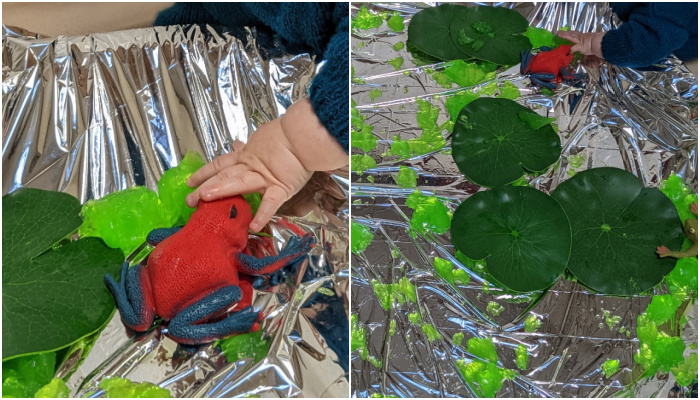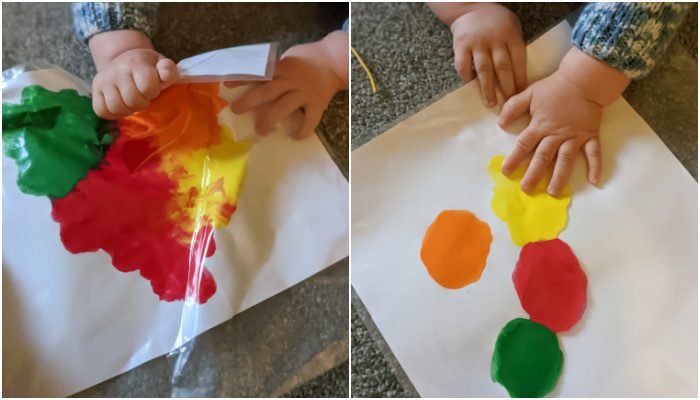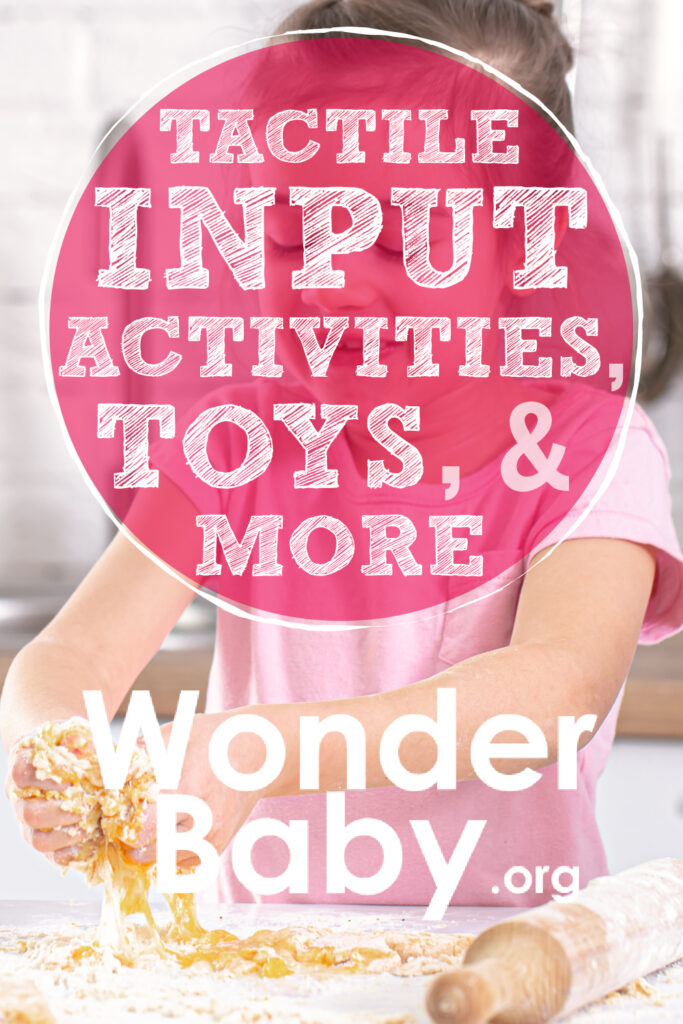14 Tactile Input Activities, Toys, & More

- Tactile input is sensory input that we receive through touch.
- All children can benefit from a wide variety of tactile activities and toys.
- Examples of tactile input activities include messy play, cooking and eating, and sensory play.
- Some children experience tactile processing issues which affect their daily life.
- An occupational therapist can support your child in identifying and planning for their tactile needs.
Children explore and make sense of their world through touch. There’s a whole interesting world of textures and sensations for them to discover! It’s important and helpful for all children to experience a wide range of tactile input activities.
Based on sensory preferences, they might avoid some things and crave others. It’s the same for adults! I seek out soft, buttery clothes, love crunchy food, and being in warm water. I hate the feel of crushed velvet, the texture of parsnips, and being in cold water.
Some children have a strong emotional reaction to the things they dislike the feel of. It becomes too much for their brains to process. These children still need plenty of exposure to tactile information, but you may need to modify their activities.
What Is Tactile Input?
It’s a common myth that the tactile system only relates to things we can touch with our hands. The tactile system is made up of sensory receptors in our skin from head to toe. It’s the largest sensory system and even includes the inside of our mouths!
The tactile system helps our central nervous system to tell between different tactile qualities. This includes textures, sensations, temperatures, and pressures.
Tactile input refers to any sensory input that our body receives from touch. For example:
- The feel of an object against our fingertips
- Clothing against our skin
- Different temperatures
- Different foods
Why Is Tactile Input Important in Child Development?
A healthy tactile system helps children to function more readily in everyday life. Think about all of the areas of a child’s life that involve the sense of touch:
- Eating food
- Interacting with others on the playground
- Hygiene routines like brushing teeth
- Wearing clothes
And the list goes on!
When a child has difficulty processing sensory information they can find many day-to-day activities challenging.
This in turn impacts their ability to self-regulate. A child with sensory difficulties might display challenging behaviors. This is often a parent’s first clue to there being a difficulty.
It’s helpful for all children to receive exposure to a wide range of tactile input but can be especially vital for those who struggle with sensory processing.

How to Tell That a Child Has Tactile Sensory Issues
In their commentary on Ayers framework of sensory integration, Katherine Guardado and Shane Sergent, DO, note that “children with sensory processing deficits may find it challenging to regulate their responses to everyday situations such as dressing, playing, mealtime, and social interactions.”
For a child with tactile sensory needs, you may notice some of the following traits:
- Sensitivity to certain textures, which may lead to an aversion to certain types of clothing. Or, they may constantly try to touch everything around them.
- Lack of variety in diet; food preferences may be very limited.
- Discomfort in cold or warm weather. They may not notice the temperature or be sensitive to it.
- Responds negatively to light touch or unexpected contact with others, for example in the playground. Or, may purposely seek to touch other people. May lack personal space awareness.
- May not notice that they are dirty, or has difficulty with personal hygiene.
The types of tactile needs can be separated into two main categories, which are:
Tactile Defensiveness or Over-responsive
Tactile defensiveness (also known as “sensory avoiding”) is when a child has difficulty processing tactile input and finds it overwhelming or overstimulating.
A child who has tactile defensiveness typically responds with a “fight or flight” response to unwanted sensory input. They may become extremely frustrated by unwelcome touches and touch-based activities and will actively try to avoid these.
A child experiencing tactile defensiveness might struggle with the feeling of a label in their clothes, the texture of certain foods, and routines such as brushing their hair or having a bath.
Tactile Seeking or Under-responsive
For a child experiencing an under-responsive tactile system, the sensory information they receive is not fully processed, creating a craving for more tactile input.
This child may either seem withdrawn or always on the go, looking for more and more things to touch and explore.
A child experiencing this craving for more tactile input might not enjoy sitting still and might constantly want to touch objects and people. They may not notice they are dirty, struggle to register different temperatures, or have a noticeably high pain threshold.
Other Sensory Systems
Most (but not all) children who experience sensory processing problems are affected in their tactile system.
They may also have difficulty with one of the other sensory systems. Most notably, the vestibular system or proprioceptive system.
A sensory checklist can be a good place to start if you feel your child may have difficulty with sensory input across one or more areas.

7 Activities That Help Promote Tactile Input
All children benefit from a wide range of tactile experiences.
For a tactile seeker, the more touch-based input you can give them the better! They will love exploring a variety of sensations.
A more gradual approach is required for a child with tactile defensiveness, this is best planned alongside an occupational therapist.
As Horwood and Caldwell suggest in their sensory integration handbook, these children “still need a great deal of tactile input and often crave it, but it needs to be controlled and combined with deep pressure input.” Start slow and never force these experiences.
These are some of my favorite ways to incorporate tactile input into your day!
Messy Play
You may shudder at the idea of the preparation and cleaning up for messy play—I get it! But messy play can actually be kept surprisingly clean if you keep it outside or contained (for example on a special wipe-clean messy play mat).
Some popular choices include slime, playdough, jelly, or shaving cream. Remember to have spare clothes on hand!
Outdoor Play
Some of my favorite tactile experiences can be found outside.
Have fun exploring the textures of nature together (rough tree bark, crunchy leaves, squishy mud). Gardening, going on a nature walk, or simply visiting a playground or park offer a huge range of tactile experiences for your little one.
Sensory Bins
A sensory bin is one of my favorite tools for increasing sensory input. It’s as simple as adding different items to a bin or container to explore.
You can fill your sensory bin with almost anything! Some of our favorite combinations are:
- Sand with scoops and diggers
- Water beads and plastic animals
- Dried rice, beans, and pasta
- Edible slime and rubber frogs
- Water and different-sized jugs
Arts and Crafts
There are so many different textures to explore when your child is creating art! Different textures of paper and cardboard, clay, glue, and paint all provide different tactile experiences.
Finger painting is a great way to get some sensory input while making art. For tactile defensive-friendly play, use a ziplock bag with your paint and paper inside to gradually introduce paint without the mess.
Food
Cooking and baking with your child is an amazing opportunity for engaging the tactile system. Get your child involved with mixing cake ingredients, rolling dough, or just everyday cooking experiences!
If you can expose your baby to finger foods from the first stages of weaning, they will be exposed to many different textures (both in their hands and in their mouths!).
Feely Bag
Using a feely bag helps your child to really concentrate on the feel of an object and is a fun game!
Add a variety of items to an opaque bag and ask your child to feel inside. Younger children can simply explore, while older children can describe and guess what they’re feeling.
Proprioceptive and Vestibular Input
Two other systems, the proprioceptive and vestibular, also have an important role to play in sensory processing. These activities can help a child with tactile processing needs too and are often a lot of fun!
We have lots of ideas for proprioceptive input activities and vestibular input activities.

7 Tactile Input Toys That Kids Will Enjoy
If you’re running out of ideas to satisfy your sensory seeker, it can be helpful to use toys and books that provide tactile feedback.
“That’s Not My” Board Books
- Style: Childrens Books
- Open Height (mm): 168
- Open Width (mm): 336
- Number Of Pages: 10
This fantastic series of books all follow a similar structure, with interesting tactile patches on every page.
I love that these books give your child the vocabulary to describe the textures they’re feeling. They’ve remained a firm favorite for my son from just a couple of months old! You can find a “That’s Not My” book on almost any subject, so it’s easy to tailor to your child’s interests.
Kinetic Sand
- SQUEEZABLE FUN: Kinetic Sand is 98% sand & 2% magic Pull it, shape it & mold it to create incredible sand art. Kinetic Sand sticks to itself & not to kids so it can be easily cleaned up & stored
- MESS-FREE SENSORY FUN: A great addition to your child’s collection of sensory toys, Kinetic Sand flows through fingers like real beach sand & leaves them completely dry. When pressed together it sticks to itself & keeps its shape
- MADE WITH NATURAL SAND: Kinetic Sand is safe for pretend play, arts & crafts, sand art and kids crafts It’s made from natural sand and magically sticks together for easy clean up
- CREATE & PLAY: Make whatever you dream of with an array of multi colored sand, from brilliant neon colors to shimmering metallic ones that sparkle & shine It’s the squeezable sand you can’t put down
Love going to the beach but hate the clean-up?
Kinetic sand gives your child the chance to explore the feel of sand and make fun creations without it getting absolutely everywhere! Kinetic sand makes for some super addictive playtime, even for adults!
Touch & Match Board
- HELP YOUR CHILD LEARN — This interactive fidget puzzle encourages the development of sensory, fine motor and descriptive language skills.
- 12 COLORS AND TEXTURES TO MATCH — Choose a counter and find the same surface covering on this sensory puzzle. Use blindfolds for an extra challenge while matching!
- ASSIST GROWTH OF SENSORY AWARENESS — A multi-sensory busy activity which combines visual perception skills with tactile awareness.
- EXCELLENT RESOURCE FOR THOSE WITH AUTISM — A useful sensory stimulation and reasoning activity for children with special education needs or autism.
These beautiful touch boards may a perfect sensory toy for toddlers! They allow your child to explore different textures and match them.
For older children, try matching the textures while blindfolded for an extra layer of challenge!
Galaxy Slime Kit
- [MAKE GALAXY SLIME]- Simple follow the instructions to make galaxy slime with ingredients supplies and galaxy style add ins. The slime toy give kids a magical outer space feeling, share long time happiness with friends.
- [EASY SLIME]- FunKidz slime for boys girls use premium material which form more easier. The made slime super soft and stretchy. Due to concentrated slime glue, remember to pour 2-3 times clear water to attenuate glue before mixing with slime activator. You will make at least 1000 milliliter basic slime total.
- [PERFECT GIRLS SLIME GIFT] Our girl slime kit for 6, 7, 8, 9, 10, 11, 12 years old is an excellent gift choice. Suitable for any occasion such as birthday party, festivals, holiday, school or carnival prizes and Christmas stocking stuffers.
- [SUPER FUN FOR KIDS]- Add colorful beads, glitters, foam and glow in the dark stars into premade galaxy slime, let the slime become more beautiful and shiny. Realize children’s dreams of becoming an astronaut.
Okay, so you could just make “regular” slime. But why not make it extra inviting with galaxy themed slime?!
This kit has everything your child needs to make amazing slime creations—including glow-in-the-dark slime!
3D Pin Art Sensory Toy
- Inspire Creativity & Imagination: Anything size fits the wall of this plastic pins you can press it into the pin wall to leave an identical profile,make a toy statue, handprint or facial outline.It will create amazing 3d sculptures, inspiring kid’s infinite creativity and imagination.
- 3D Pin Art Toy Board: Both edges of the pin is smooth and harmless for playing,clone your favorite print and keep it as memento,and anytime you want to make a new print you place it horizontally and it’s back the way it was.
- Perfect Decoration:Press it your favorite print and it looks beautiful on anywhere,bedroom,bathroom,living room,measures 8.5×6.5×2.8 inches,it won’t take up too much space.
- Colorful Plastic Pin Art Toy:Made of colorful plastic pins and a sturdy transparent frame,durable and foolproof interesting novel toy for kids.
I used to have one of these pin boards as a child and spent endless hours pressing my hands, feet, and even my face into the pins to create different prints.
A nice thing about this toy is the instant feedback showing how your touch and pressure has left a creative impression.
Mud Kitchen
- Durable Wooden Construction: Wood play kitchen is made from high-quality solid wood, it’s built to withstand outdoor play and provide long-lasting fun.
- Versatile Play Options: Kids Kitchen Playset features both cooking and water play capabilities, allowing kids to enjoy a variety of activities in one set.
- Encourages Imaginative Play: Kids mud kitchen inspires creativity and role-playing as children pretend to cook and serve, enhancing social skills and teamwork.
- When playtime fun is done, Use the cabinets, pull-out drawers, dish rack, and bins to neatly store all of the included accessories. The dimension of toy kitchen is 36.2”x14.96” x36.2” (H)
It’s not the cheapest way to find tactile experiences, but I am yet to meet a child who doesn’t love a mud kitchen!
Children can play pretend-chef with mud, water, and anything else nature has to offer with this outdoor mud kitchen. It even has a working faucet!
Sense and Grow Sensory Bean Bags
- Discover Textures and Shapes in a Hands-On Way: Pull sensory beanbags out of your burlap bag to identify their shape, texture, and color; Enjoy a unique kit that indulges the sense of touch; Read all about the benefits of sensory play with the Sense & Grow guide that is attached to each box
- Treat Your Senses: Develop coordination, exploration and color recognition with the Sense & Grow Products; Improve hand-eye coordination, dexterity, and fine motor skills as you explore the sense of touch with these textured beanbags
- Feel, Squeeze and Discover Creativity: Help kids get creative by letting them identify the material, texture, shapes and colors of the beanbags; Then, have them compare it to items around the house. This sensory kit included 9 beanbags that are all wonderfully different and satisfying
- Big Gift for Little Ones: Give a gift that will delight parents as well as kids; It’s the perfect holiday or birthday present that will keep them entertained long after the party is over
These bean bags are a brilliant ready-made feely bag game. They have a range of textures and shapes for your child to discover.
The same company have a whole range of tactile sensory toys, including this Sea Life Slime Sensory Bin.
- Contain(er) Your Slime For Mess-Free Fun: Explore the wonderful texture of slime with a unique activity kit that indulges the sense of touch; Play with sea animal figurines inside of the provided container so nothing gets lost or messy; Read all about the benefits of this kit with the Sense & Grow guide to sensory play that’s attached to each box
- Treat Your Senses: Develop coordination, exploration and color recognition with the Sense & Grow Products; Improve hand-eye coordination, dexterity and fine motor skills as you explore the sense of touch
- Dig, Explore, and Discover Creativity: With this kit, you’ll be able to create many scenes using the slime and accessories; Take your new little friends on ocean adventures all over the slime or find household items around the house to bury and then dig up
- Big Gift for Little Ones: Give a gift that will delight parents as well as kids; It’s the perfect holiday or birthday present that will keep them entertained way after the party is over
FAQs
Can a child outgrow tactile input issues?
The answer to this is complex, as it depends on the underlying cause and severity of each individual case.
What experts do know is that early and targeted intervention can have a big impact. A small 2007 study by Lucy Jane Miller, PhD, OTR, Joseph Coll, and Sarah Schoen, PhD, OTR found that occupational therapy input made a significant difference for children with sensory processing difficulties.
Some children, for example those on the autistic spectrum, may need long-term modifications to support them with their tactile processing difficulties.
Can a child have sensory issues and not be autistic?
Research by Nicolaas Puts, PhD, et al. notes that “Impaired responses to tactile stimulation are a commonly reported symptom among children with autism spectrum disorder (ASD).” This does not mean that a child with sensory aversion is also autistic, but could be an indicator.
It’s important to work with your primary care provider or pediatrician to investigate any concerns about sensory processing.

Related Posts

Eye Conditions and Syndromes, Visual Impairment
Neuralink Announces Plans to Restore Sight to the Blind with Brain Chip
Elon Musk’s company Neuralink has announced plans to begin human trials of its new “Blindsight” brain chip by the end of 2025.

Special Needs
5 Spring Cleaning Tips for Families of Children with Disabilities
Spring cleaning is an opportunity to create a more accessible, organized, and supportive space for your child with disabilities. Declutter, deep clean, and refresh!

Visual Impairment
The Gift of Understanding: How a Young Child Helps His Blind Father Navigate Life
When a parent is blind, it’s natural for people to wonder how their sighted child will adapt. Will they struggle to understand their parent’s needs? Will they feel burdened by...







